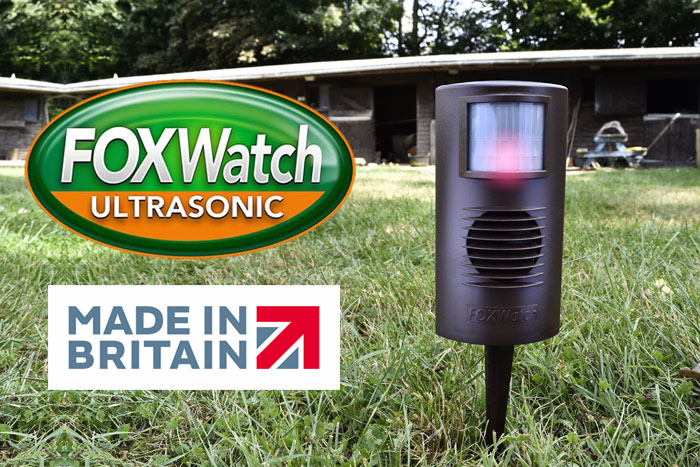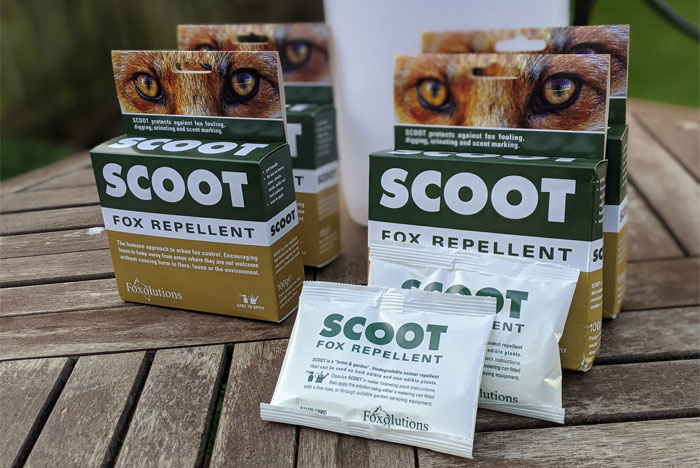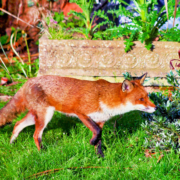10 reasons foxes come into your garden (and what to do about it)
If you’ve got foxes coming into your garden and pooing, digging or causing damage, then this article will help you understand what might be attracting them and what you can do to stop them.
What do foxes like about your garden?
“Why do foxes keep doing this?!” you’ve probably cried out in frustration after yet another large hole, dug-up plant or prominent poo appears in your garden.
Well, there are many reasons why foxes might find your garden attractive. While some are quite obvious, there could be factors you were unaware of that encourage foxes to keep returning time after time.
Underlying all the different reasons is one central point – the positives of coming into your garden are currently greater than the negatives. The foxes have got into the habit of thinking your garden is beneficial to their well-being.
Your goal should be to break this habit and create an unwelcoming atmosphere that teaches foxes to alter their behaviour and spend less and less time in your garden.
Successful fox deterrence can be achieved by a combination of minimising whatever it is foxes like about your garden and an element of irritation or risk through a good quality fox deterrent.
Below are the most common reasons foxes are attracted to gardens, including advice designed to help you improve your frustrating situation and take back control of your garden.
1. EASY-ACCESS GARDEN
At the moment, the fox could be finding it very easy to get into your garden without facing any kind of challenge or obstacle on its route in.
Over a wall, through a gap in the fence, across a flat roof – these are a few of the common ways foxes enter gardens and it’s important you work out how a fox gets into yours.
The entry point is where you have the biggest opportunity to influence a fox’s decision to either enter your garden or go elsewhere. Fortunately, foxes are creatures of habit and will usually enter at the same place each time.
Look at the area from a fox’s point of view and see if there’s anything you can do to make it more difficult to come in.
Mending broken fences, putting a spiky potted plant in the way, installing plastic spikes [aff] along ledges are possible solutions. The more difficult it is for a fox to access your garden, the more likely it is to give up and go somewhere else where it’s easier.
2. GOOD HIDING PLACES
When searching for somewhere to live, foxes will make a mental map of their local area and know the best places to make a den or to run to in case of emergency.
Foxes know which gardens have semi-permanent wooden constructions (like sheds or decking), which ones are overgrown and which ones are filled with junk (e.g. pallets, old machinery, boxes and tyres).
If a fox can get behind, underneath or inside something without being disturbed, then it most certainly will. Therefore it’s important that you block up or remove anything a fox might want to hide in, otherwise you’re leaving yourself open to regular visits.
Between November and February, foxes are particularly keen to find somewhere secluded and comfortable to birth and raise cubs. Once they’re entrenched in a den, it can be hard to get foxes out until the cubs can fend for themselves.
Blocking up* potential hidey-holes and removing any junk or heavy undergrowth is an important step to take in making your garden less likely to be inhabited by foxes.
* Please note that it is illegal (and very cruel) to block up a fox den that is still in use, so you will need to make sure it’s empty or wait for them to vacate it before doing so. An easy way to check if a den is in use is to stuff an old sheet of newspaper in the entrance. If it’s still there after 2 or 3 days, you can assume it’s not being used and can block it up.
3. OPEN PATCHES OF SOIL
Foxes enjoy eating earthworms and grubs, so they will automatically head to any area of soil in order to dig for them.
Flowerbeds, planter boxes, potted plants, vegetable patches and seeded areas are all places foxes gravitate towards. You may have noticed that the problem increases after heavy rain because the ground is softer and earthworms rise to the surface.
Fox cubs also enjoy practising their digging skills in these areas too because the soil is easy to displace and soft on their paws.
If you have several areas of open soil areas in your garden, then taking steps to protect them will stop the fox associating your garden with easily-accessible food. In turn, they’ll spend less time in your garden and less time destroying your plants.
DigStopper Prickle Strips [aff] are rows of plastic spikes that you can roll out into your soil, or in pots and boxes. They’re very easy to install and are effective at stopping foxes from digging because the spikes are sharp enough to feel unpleasant underfoot, without being dangerous.
4. SCRAPS FOR THE BIRDS
If you throw out leftover food scraps onto your lawn for the birds, then bear in mind that you might be attracting foxes as well, especially if the scraps are meat-based.
This is not to suggest that you stop feeding the birds altogether, but thinking about how and what you feed them will help to stop foxes associating your garden with meaty morsels.
Installing a bird feeding station [aff] and putting non-meat, bird feed in hanging feeders and on tables keeps food up off the floor. Dominant ‘birdtablers’, like starlings and pigeons, naturally drop a lot of food on the floor anyway, so ground-feeding birds will still be catered for.
Seeds, peanuts, sunflower hearts, mealworms, insect suet and fat balls provide everything birds need, but without the strong smell given off by meat and other kitchen scraps.
As well as foxes, waste food also tends to encourage rats and mice, so restricting things to nuts and seeds should minimise this problem. Hanging feeders also make birds less of an easy target for cats.
We have foxes digging holes in our back garden. My mum throws out bread and sometimes kitchen scraps for the birds. We didn’t realise that might be what is encouraging foxes!
– Hemal, Middlesex
5. THINGS LEFT OUT OVERNIGHT
If you tend to leave things out in your garden overnight, then this could be a serious temptation for a fox.
Children’s toys, dog chews, shoes, wellies, hiking boots, tools and gardening gloves are all common things that tend to get left out overnight.
Fox cubs are always curious about items left in the garden and often see them as an invitation to chew, play, or practise hunting. Adult foxes will also grab them, either to demonstrate something to cubs or mistakenly thinking they are food.
Many of you will have experienced items like this either being pooped in, urinated on, chewed or even lost. Bringing such items in overnight will cause less inconvenience for you and provide the foxes with one less reason to be in your garden.
6. DOG AND CAT FOOD
If you have a cat or dog, then you’ll know how strong-smelling their food is. So imagine how strong that scent is to a fox!
While some pets eat all their food in one go, some choose to eat a bit and come back to finish it later. If your cat or dog likes to eat slowly, there will be a significant amount of time where the food is just sat in the bowl acting like an open invitation to foxes.
If you feed your pet outside, try and be vigilant when it walks away from its dish and cover up the food or even pick it up and put it out of reach. If you have a cat flap, don’t leave food uncovered overnight as foxes are more than capable of sneaking in to polish it off, terrifying your cat in the process.
The more you can suppress the smell of pet food, the less tempted a fox will be to enter your garden.
Last week a fox invaded my flat. It actually entered through the cat flap, god knows how, it is huge! It is causing damage but my main concern is my house cat which is now unable to go outside.
– Moya, London
7. CHICKENS, RABBITS, GUINEA PIGS
Although urban foxes don’t kill as many small pets as you might think, they are still going to be tempted into a garden that contains chickens, rabbits, guinea pigs and other small mammals (a.k.a. ‘prey’).
If a fox does get into a pen or cage, it will kill everything in there in an act known as ‘abundance killing’ – making the most of the food available with the plan of burying it all for retrieval at a later date.
The best thing you can do is to make sure the housing for your animals is very secure. This means no flimsy doors or weak metal meshing, otherwise they’re going to be easy targets.
Put yourself in the position of a fox and do your best to ensure there are no areas of weakness.
A good way of disguising the smell of your small animals is to use clumps of dog hair. The hair can be strategically stuffed into meshing, cracks and other nooks and crannies in your cages or chicken houses. If you’ve got a dog, bring back some hair with you next time it gets clipped.
You may also wish to consider some good quality electric netting if you’ve got a substantial outdoor animal collection.
8. ANIMAL-BASED FERTILISERS
As any keen gardener will testify, adding a fertiliser to your soil provides huge benefits to plants, helping them receive the essential nutrients they need in order to thrive, such as nitrogen, phosphorus and potassium.
A popular ingredient in plant food is a type of ‘meal’ – finely ground up animal bones, blood and other waste products from slaughterhouses or fish farms.
These animal by-products contain a lot of the important nutrients for plant growth and are classed as organic, slow-release fertilisers that are good for the soil.
However, they’re definitely not vegetarian and could be responsible for drawing foxes into your garden.
Fertilisers containing bone, blood or fish meal often give off a strong ‘dead animal’ scent that may not be obvious to human noses, but are absolutely detectable to a fox’s far superior sense of smell.
If you’ve been using fertilisers containing animal products, consider switching to a plant or seaweed-based fertiliser [aff] that won’t be attractive to foxes.
9. BURIED PETS
Foxes constantly ‘cache’ food – burying it underground and returning to it at a later date when they need it.
Their amazing sense of smell and cognitive abilities allows them to locate where they’ve buried the food in order to dig it up again in the future.
Unfortunately they often treat buried pets in exactly the same way, smelling the strong scent and digging them up as if they’d buried it themselves. Anyone who’s discovered the aftermath of a dug-up, dearly departed pet will understand what an unpleasant experience this is.
An effective way of avoiding this unpleasant experience is to put heavy stones or a paving slab on top of the grave for a few months, until the smell becomes too faint to be detected by foxes.
Alternatively, you could lay down some DigStopper Prickle Strips [aff] over the top to provide extra protection from digging.
10. WATER FEATURES
Foxes need a stable and consistent water supply and will be very aware where the best source of water can be found in their territory.
If you have a pond or water feature that is uncovered, then the fox might consider your garden the most reliable place for drinking water and will keep coming back time and again.
If you can, make it difficult for the fox by covering your pond with protective netting [aff] or by blocking off the most accessible parts of your water feature with tall potted plants.
Anything you can do to make the fox work harder to get to the water, the more likely it will give up and go somewhere else.
EXTERNAL REASONS
In the points raised above, we’ve looked at things within your control that could be giving foxes a reason to enter your garden.
However, it’s also possible that there are factors outside the boundaries of your garden that are attracting foxes to the area.
These can include:
Public parks & green spaces
Areas such as parks, commons, woodlands, copses, golf courses, recreation grounds, playing fields are all ideal fox habitats.
This is due to the abundance of living space, and also because they are often in close proximity to urban areas where there’s plenty of food. The best of both worlds.
If you live close to any of these types of green spaces, it’s likely foxes will be living in them, venturing into your neighbourhood to get food.
Railway lines
If you ever look out the window of a train that is travelling through an urban area, you’ll often see banks of untouched undergrowth, flowers and trees next to the track.
These areas are usually completely inaccessible to humans and as a result provide a perfect place for foxes to set up home.
Additionally, most railway lines cut right through the heart of our towns and cities and they actually make it an easy and safe way for foxes to navigate their way around.
If you live close to a railway track, this could be a reason why you’re seeing foxes in your garden.
Neighbours feeding foxes
A survey of over 11,500 participants showed that 36% of people in urban areas said they fed foxes on a regular basis.
On one hand, foxes are not short of food in our towns and cities and don’t need humans to provide food in order to thrive.
On the other hand, being able to see a wild mammal up close is exciting, so it’s understandable why some people might actively encourage foxes to their gardens by feeding them.
Whichever side of the fence (literally) you’re on, a fox cannot distinguish between a neighbour who likes foxes and another who doesn’t.
It’s very possible that a fox is coming into your garden because a nearby neighbour feeds it.
What can you do?
Though you can’t change the environment outside your garden, you do have control over what you do inside your garden to make it as unwelcoming as possible to foxes.
One of the best ways to do this is to locate the point where foxes enter your garden and use a combination of deterrents to protect and fox-proof the area.
USE AN EFFECTIVE FOX DETERRENT
The purpose of a humane fox deterrent is to get the fox to start associating your garden with something irritating, annoying or uncomfortable.
Your efforts to minimise any foxy temptations will have started this process to a certain extent, but using a deterrent will take it to the next level.
The following deterrents do not cause any harm to foxes (or pets and wildlife), but they do encourage this important behavioural and attitudinal change to your garden.
Using more than one type of deterrent in your garden will help to speed up this change. If multiple instincts (e.g. hearing and smell) are putting the fox on alert, the less time it will want to hang around in the area to dig, foul or chew.
Successful fox deterrence is not an exact science, nor is it something that happens overnight. But with a little patience and keeping what you’ve learnt in mind, the situation will gradually improve, enabling you to get back to enjoying your garden.
FOXWATCH ULTRASONIC DETERRENT
The FOXWatch Ultrasonic Deterrent is a small device that sits in your garden and emits high-pitched bursts of noise every time a fox walks in front of its infrared motion sensor.
Foxes find the noises irritating, so the FOXWatch acts as a training device, effectively teaching foxes to associate your garden with the annoying high-pitched noises.
This gradually causes the foxes to spend less and less time in your garden and reduce the frequency of their visits as they naturally seek to avoid the ultrasonic sounds.
Consequently, you’ll spend less time dealing with typical fox problems like:
- Digging
- Fouling
- Plant and lawn damage
- Chewing

“We’ve seen a dramatic improvement…”
We recently landscaped our garden and, almost on cue, the neighbourhood fox descended upon us. It did significant damage – removed plants, dug a burrow under our new garden shed, lifted our artificial turf and covered the fences and paving with hundreds of muddy footprints. We installed a FOXWatch and…have seen a dramatic improvement since; the occasional footprint appears overnight, but our garden has clearly become less hospitable for foxes, and they are spending minimal time there now (having once considered it suitable as a long term home!).
The FOXWatch can be up and running in less than 5 minutes and can either be pushed into the ground using the attached plastic spike, or mounted on a wall or fence (no higher than 8 – 10 inches off the ground).
The best place to install it is in an area where you know the fox will have to walk in front of the device when coming into your garden. This is usually facing the entry point we discussed at the beginning of this article.
The unit is powered by a 12 Volt mains adapter or 9 Volt Duracell battery and can simply be switched on when you’re ready to use it.
You can then leave the FOXWatch to go about the process of teaching the fox to associate your garden with the annoying ultrasonic noises so that their visits become fewer and farther between.
- Teach foxes to stay away from your garden
- 100% humane – no sprays or chemicals
- Safe for cats, dogs and other pets
- Easy to set up in less than 5 mins
- Protects an area of up to 125sqm
- Gets more effective over time
- Weather resistant
- Inaudible to humans
- Made in the UK
The FOXWatch is available to buy in the Fox Repellent Expert store priced at £69.95. Each device comes with a 12 Volt mains adapter, full set-up instructions, 2 year manufacturer’s warranty and free UK delivery.
As the FOXWatch deters foxes through sound, an effective scent-based product to use in conjunction with it is Scoot Fox Repellent [aff].
Scoot is an easy-to-use deterrent that takes advantage of the way foxes protect their territories and uses it against them.
Foxes are very territorial and spray their strong-smelling urine around prominent parts of the area to send out the message to neighbouring foxes that your garden is occupied.
Scoot works by covering up these scent marks with a new smell, tricking the fox into thinking a rival is trying to take over the territory. Repeated spraying of Scoot makes the fox think it has lost the battle and as a consequence it will spend less and less time in your garden in order to avoid potential confrontation.
Each box of Scoot contains two 50g sachets of powder and each sachet can be diluted with water (minimum 2.5 litres, maximum 9 litres). Once diluted, Scoot can be sprayed on the areas where digging and fouling have occurred, as well as around the fox’s entry point to your garden. A pump action pressure sprayer [aff] is a good way of ensuring the solution is spread evenly.
It’s important to note that spraying Scoot will often initiate a short ‘scent war’ between the fox and its supposed rival. This involves the fox urinating more than usual in a desperate attempt to reestablish control of your garden, but thankfully this doesn’t last long provided you continue to spray the Scoot. Ideally you should spray it every 2 or 3 days for a couple of weeks, as it’s through the repetition and constant renewal of the scent that you convince the fox it’s lost the battle.
Scoot is pet and plant friendly, but needs to be sprayed in the dry and then reapplied after heavy rainfall to maintain the concentration of the scent. For this reason, and the fact you need to outlast the fox in the scent war, you’ll probably find a Scoot Multipack to be the most cost-effective way of achieving the desired results.
- Easy to mix with water and spray
- Safe for cats, dogs, pets and wildlife
- Harmless to plants and grass
- Helps to reduce fouling, digging and garden damage
- Scentless to humans
- Covers up to 16sqm per sachet
Scoot is available on Amazon UK priced around £33 for a multipack, which contains 8 x 50g sachets.
Some of the links on this page may contain affiliate links (aff), which means we receive a commission (at no extra cost to you) if you use that link to make a purchase. We appreciate your use of these links as it helps to keep this website running. Thank you!






 Photo credit: John Ondreasz - Pixabay
Photo credit: John Ondreasz - Pixabay Photo credit: Adam Lowly | Pexels.com
Photo credit: Adam Lowly | Pexels.com Photo credit: Concept Research
Photo credit: Concept Research




